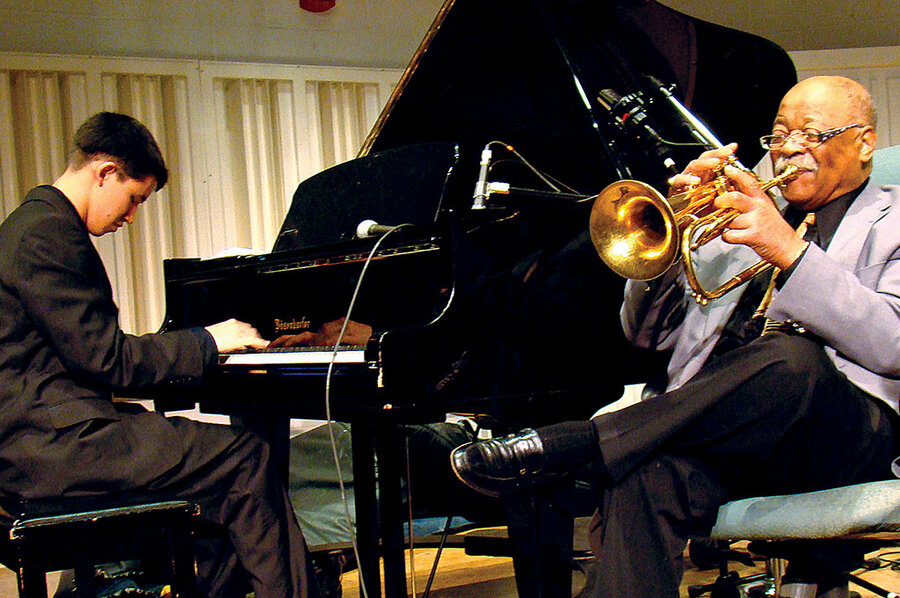'Keep on Keepin' On' focuses on life in music and the joy it can bring
Loading...
Clark Terry, the 93-year-old jazz legend and one of the few performers to have played in both Count Basie’s and Duke Ellington’s bands, was once quoted by Dizzy Gillespie as having “the happiest sound in jazz.” That happiness still radiates, despite a series of major health setbacks, including encroaching blindness and, several years ago, the amputation of both legs.
Terry is the subject of Alan Hicks’s documentary, “Keep on Keepin’ On,” filmed over four years, but he’s not its only focus. An Australian drummer, Hicks was hired to tour with Terry’s jazz ensemble in the mid-2000s after he had come to America to study music at William Paterson University in New Jersey.
While at Paterson, Hicks met Justin Kauflin, a gifted jazz pianist blind since sixth grade, and subsequently introduced him to Terry – or C.T., as his friends call him – in order to help him cope with his own worsening eyesight. The two men – 66 years apart – became fast friends, and Terry became Kauflin’s musical mentor. Since music is so much more than music between these two, their filmed sessions resemble not so much rehearsals as communions.
Barely able to sit upright, with oxygen tubes in his nostrils, Terry hums riffs and Kauflin, on piano, picks up their lilt and extends them. It’s a beautiful thing to see. When Kauflin, who suffers from stage fright, enters the Thelonious Monk International Jazz Competition, Terry gives him his “lucky socks.” (Kauflin was a semifinalist.) He tells the boy, “I believe in your talent and I believe in you,” and he means it.
Coming from Terry, one of the most recorded musicians in the history of jazz, this is no small ego boost. Hicks, who wisely keeps himself out of the movie (it’s his first), offers ample footage of Terry in all stages of his career. He grew up “dead poor” as one of 11 children in St. Louis, where he cobbled together his first horn using spare parts from a junkyard.
By 1948 he was playing with Basie, three years later with Ellington; he stayed eight years as a featured soloist. In 1960 he became the first black staff musician at NBC and spent 12 years with the “Tonight Show” band.
His passion for jazz education became more pronounced around this time; he mentored everyone from Miles Davis to Wynton Marsalis. He speaks of the “supreme joy in helping young musicians.” One of those musicians was 13-year-old Quincy Jones, his very first pupil, and, as Terry describes him back then, “skinny enough to ride a rooster.” Jones, now 80, and Terry became lifelong friends and musical collaborators, and Jones, who coproduced the documentary after being asked to appear in it, provides its most heartfelt moment when he visits his ailing mentor in his home in Pine Bluff, Ark. Jones’s tender, abiding love for this man shines through, and, almost wordlessly, is returned in kind. (Extending the cycle of mentorship, Jones becomes so taken with Kauflin’s playing while visiting Terry that he ends up signing him to a record deal.)
Terry’s wife, Gwen, who met him at a 1990 tribute to Ella Fitzgerald and who co-wrote his autobiography, is a constant, consoling presence.
Watching her husband jam with Kauflin, she tells him, “I may not know the technicalities of jazz, but I know when you’re happy.”
Actually, Terry seems happy just about all the time. An inveterate storyteller, he was known in the jazz world for keeping the latest hours and also arising before anyone else. His 1963 scat classic “Mumbles,” which we see a clip from, is such a glorious swatch of vocalized nonsense that it makes you grin ear to ear just listening to it. He talks in the film about “getting on the plateau of positivity,” and if anybody ever embodied the truth of his own words, it’s Clark Terry. Grade: A- (Rated R for some language.)





